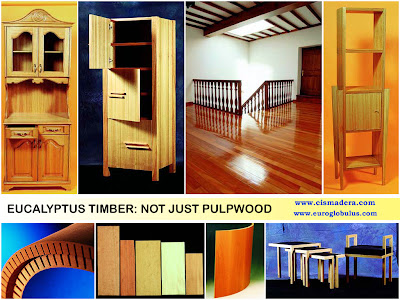COLD HARDY EUCALYPTUS TIMBER GROWING & HARVESTING
A pictorial review of Eucalyptus Forestry in the Highlands of Galicia, Spain
Gustavo Iglesias Trabado

GIT Forestry Consulting - Consultoría y Servicios de Ingeniería Agroforestal - www.git-forestry.com - EUCALYPTOLOGICS
 Fig. 1: Example of Eucalyptus nitens tree growth (1): DBH-80 in less than 20 years. (Click to enlarge)
Fig. 1: Example of Eucalyptus nitens tree growth (1): DBH-80 in less than 20 years. (Click to enlarge) Fig. 2: Example of Eucalyptus nitens tree growth (2): DBH-20 in 6 years on a pulpwood silvicultural regime. (Click to enlarge)
Fig. 2: Example of Eucalyptus nitens tree growth (2): DBH-20 in 6 years on a pulpwood silvicultural regime. (Click to enlarge) Fig. 3: Cold temperate Eucalyptus pulpwood harvest operations in Galicia
Fig. 3: Cold temperate Eucalyptus pulpwood harvest operations in Galicia1 - Basal logs: DBH-30 or bigger. Debarked on site and arranged on piles along a strip for easy operations of loading and extraction out of the forest.
2- Harvest coupe: 9 year old planting of Eucalyptus nitens (Shining Gum) at 500 m altitude on easily mechanisable tablelands.
3- Tree felling: Chainsaw operator approaching the new target and assessing the best tree felling angle. Depending on logistics of harvest this tree felling operation can be performed by an independent worker (as in this case) or by the machine at 5.
4- Typical tree: +20 meters high at a relatively high stocking (1100 trees/ha, could be less with no worries). 5 to 7 pulpwood logs per tree, 2 to 4 firewood logs per tree, 1 to 3 residual logs per tree.
5- Log processing: 4 step serial operations of handling, debranching, debarking and log cutting at desired length being performed by a forestry processor heavy machine.
6- Log loading and extraction: crane-aided loading on a timber trailer towed by a standard heavy duty agricultural tractor. From here to temporary loading yard for further loading on trucks.
7- Organic fertiliser for next crop: log processing residues (bark, branches, tree tops with leaves) remain on site to return the majority of nutrient uptake during crop maturation to the soil. They can be finely crushed in some weeks and later be partially incorporated during new planting operations as raw organic fertiliser or be arranged on strips and subject to controlled burning to use ash as fertiliser if season of the year and low forestry fire risk do allow it.
 Tasmanian Oak: Roble de Tasmania in Galicia (NW Spain)
Tasmanian Oak: Roble de Tasmania in Galicia (NW Spain)
 Eucalyptus & Snow: Winter Views of eucalypt timber plantations in Northwestern Spain
Eucalyptus & Snow: Winter Views of eucalypt timber plantations in Northwestern Spain
 Contact GIT Forestry Consulting - Eucalyptologics
Contact GIT Forestry Consulting - Eucalyptologics
 Subscribe to receive EUCALYPTOLOGICS via e-mail
Subscribe to receive EUCALYPTOLOGICS via e-mail
2- Harvest coupe: 9 year old planting of Eucalyptus nitens (Shining Gum) at 500 m altitude on easily mechanisable tablelands.
3- Tree felling: Chainsaw operator approaching the new target and assessing the best tree felling angle. Depending on logistics of harvest this tree felling operation can be performed by an independent worker (as in this case) or by the machine at 5.
4- Typical tree: +20 meters high at a relatively high stocking (1100 trees/ha, could be less with no worries). 5 to 7 pulpwood logs per tree, 2 to 4 firewood logs per tree, 1 to 3 residual logs per tree.
5- Log processing: 4 step serial operations of handling, debranching, debarking and log cutting at desired length being performed by a forestry processor heavy machine.
6- Log loading and extraction: crane-aided loading on a timber trailer towed by a standard heavy duty agricultural tractor. From here to temporary loading yard for further loading on trucks.
7- Organic fertiliser for next crop: log processing residues (bark, branches, tree tops with leaves) remain on site to return the majority of nutrient uptake during crop maturation to the soil. They can be finely crushed in some weeks and later be partially incorporated during new planting operations as raw organic fertiliser or be arranged on strips and subject to controlled burning to use ash as fertiliser if season of the year and low forestry fire risk do allow it.
Interesting links
 Tasmanian Oak: Roble de Tasmania in Galicia (NW Spain)
Tasmanian Oak: Roble de Tasmania in Galicia (NW Spain) Eucalyptus & Snow: Winter Views of eucalypt timber plantations in Northwestern Spain
Eucalyptus & Snow: Winter Views of eucalypt timber plantations in Northwestern Spain Contact GIT Forestry Consulting - Eucalyptologics
Contact GIT Forestry Consulting - Eucalyptologics Subscribe to receive EUCALYPTOLOGICS via RSS
© 2008 Gustavo Iglesias Trabado. Please contact us if you want to use all or part of this text and photography elsewhere. We like to share, but we do not like rudeness.





























0 Comments by our readers :::
Send a comment to EUCALYPTOLOGICS